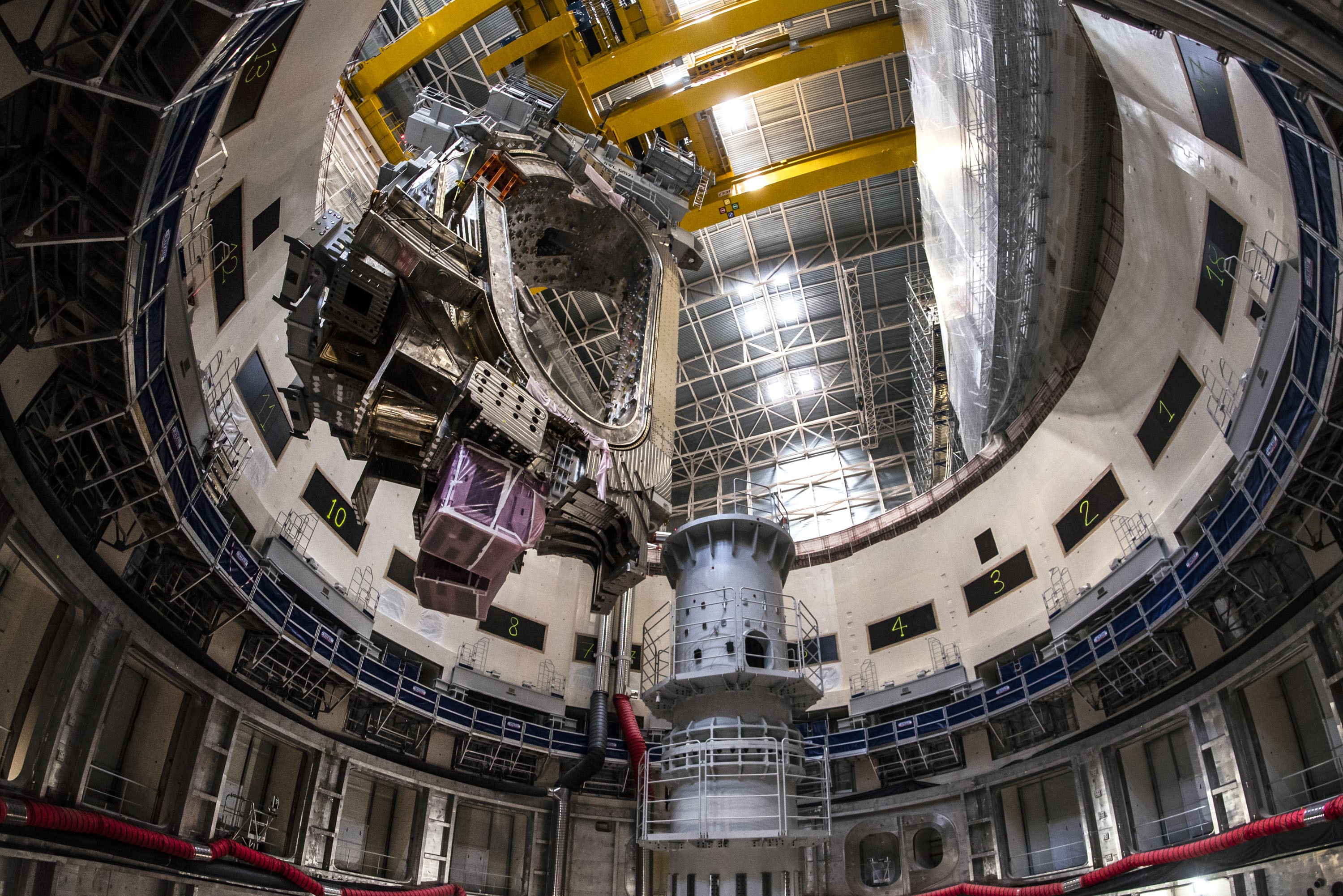Scientists have been working feverishly to decipher the process that would allow them to harness nuclear fusion, which is considered to be the “holy grail” of energy sources.
Shadowed By “Dragon”, US Nimitz-Class Aircraft Carrier Back In Focus As 3rd Witness Narrates His UFO Ordeal
Nuclear fusion is the process by which two atoms combine to form a heavier element from two lighter elements. This causes energy to be released.
Inside the sun, nuclear fusion occurs all the time, where hydrogen atoms combine under extreme heat and pressure to generate helium atoms. This releases even more energy, allowing the process to continue.
One of the most difficult challenges in modern science has been to recreate fusion on Earth, which promises a future of clean, renewable energy. The International Thermonuclear Experimental Reactor (ITER), which will be the largest device of its sort ever built and the flag-bearer for nuclear fusion, is at the forefront of this research.
On 11 May, the ITER Project achieved the major assembly milestone, as the first sub-section of the ITER plasma chamber was successfully lifted out of tooling and lowered into the machine well.
‘World Is A Customer’ – Raging Success Of Turkish Bayraktar Drones Against Russia & Armenia Boosts Its Demand
In February, scientists working in the United Kingdom announced that they had generated and sustained a record 59 megajoules of fusion energy for five seconds in a giant donut-shaped machine called a tokamak.
It was barely enough to power one house for a day, and it consumed more energy than it produced. Nonetheless, it was a truly momentous event. It demonstrated that nuclear fusion could be sustained on Earth.
ITER’s former director-general, who died on May 14 had shared his hope for fusion energy from his office, which fronted the shell of ITER’s tokamak, which is still under construction.
“Energy is life,” Bigot said. “Biologically, socially, economically.”
Bigot had said that when the Earth’s population was less than a billion, there were adequate renewable sources to supply demand.
“Not anymore. Not since the Industrial Revolution and the following population explosion. So we embraced fossil fuels and did a lot of harm to our environment. And here we are now, 8 billion strong and in the middle of a drastic climate crisis,” he had stated.
Bonjour Rafale! French Dassault Fighters ‘Inch Closer’ To Winning Indian MRFA Fighter Jet Deal – Experts
“There is no alternative but to wean ourselves off our current main power source,” he said. “And the best option seems to be the one the universe has been utilizing for billions of years.”

Nuclear Fusion: How Does It Work?
Fusion is based on the idea that energy can be released by forcing atomic nuclei together rather than separating them, as fission reactions do in conventional nuclear power plants.
The huge gravitational forces created by stars cannot be replicated on Earth, which means much higher temperatures – exceeding 100 million degrees Celsius – are necessary to push together hydrogen in the plasma produced in tokamaks.
There are no materials that can resist such heat in direct contact. To achieve fusion in a lab, scientists devised a technique in which plasma is contained inside a doughnut-shaped magnetic field where tests may be conducted.
Unlike the combustion of fossil fuels or the fission process, fusion promises plentiful energy without pollution, radioactive waste, or greenhouse gas emissions. However, even if effective, this will not be available until the second half of this century.
Challenges Ahead
Several ITER experts noted that creating fusion energy isn’t the difficult part. Humanity has been performing nuclear fusion reactions since the advent of the hydrogen bomb. The main issue is keeping it going.
The tokamak in the United Kingdom, known as the Joint European Torus, or JET, retained fusion energy for five seconds, but it is the maximum time that a machine can hold it. Its copper magnets were built in the 1970s. They would melt if they were exposed to such temperatures for more than five seconds.
On the other hand, ITER employs newer magnets that have a substantially longer lifespan, and the project hopes to generate a 10-fold return on energy, generating 500 megawatts from a 50-megawatt input.
The purpose of ITER is to demonstrate that it can retain fusion energy for considerably longer than JET was able to. If this project is successful, commercial-scale equipment will be able to generate fusion in the future.
Although the Sun produces helium by fusing hydrogen atoms, the JET project used two hydrogen isotopes termed deuterium and tritium, which will also be used in ITER. In terms of chemical makeup and reactivity, these isotopes are nearly identical to hydrogen.
However, the initiative still has one more hurdle to overcome. The issue is that by the time ITER is complete, there may not be enough fuel to keep it running.
For its experiments, ITER, like many of the most well-known experimental nuclear fusion reactors, depends on a constant supply of both deuterium and tritium. Although deuterium may be obtained from seawater, tritium, a radioactive hydrogen isotope, is extremely rare.
Tritium is rare, but it can be manufactured synthetically. Only 20 kilos are available in the world at the time, and demand is limited to 400 grams every year.
Currently, Tritium for fusion experiments like ITER and the smaller JET tokamak in the UK comes from a very specialized sort of nuclear fission reactor known as a heavy-water moderated reactor.
However, many of these reactors are approaching the end of their service life. Approximately 30 remain in operation around the world—20 in Canada, four in South Korea, and two in Romania, each generating roughly 100 grams of tritium each year.
Tritium is a very expensive substance, with a single gram costing around $30,000. If nuclear fusion goes mainstream, demand will skyrocket, posing yet another challenge to the world’s fusion experts.
A Complex Project
The project, which spans 39 construction sites, is extremely complicated. The main job site is a sterile environment where massive components are installed with the assistance of 750-ton cranes.

The engineers have completed the tokamak’s shell, but they are still waiting for several components, including a massive magnet from Russia that will sit atop the machine. The tokamak will be 23,000 tonnes when finished.
Three Eiffel towers combined weigh that much. It will be made up of a million parts, each of which will be broken down into no less than ten million smaller ones.
This will be encircled by some of the world’s largest magnets. They are too large to transport and must be built on-site in a vast hall because of their enormous size (some have diameters of up to 24 meters).
The digital design of this massive machine is spread across multiple 3D computer files that take up over two terabytes of disc space. That’s the same amount of space that 160 million one-page Word documents might be stored on.
Question Over Russia’s Participation?
ITER, which is managed by seven primary members — China, the United States, the European Union, Russia, India, Japan, and South Korea – involves 35 countries.
However, the conflict in Ukraine casts a cloud over Russia’s involvement in the project. There are concerns over the country’s continued participation in ITER, as well as its possible exclusion.
In the aftermath of its war, Russia was kicked out of several other international scientific initiatives, but the European Commission specifically exempted ITER from the restrictions. This is partly due to Russia’s historical ties to both the project and fusion energy.
ITER was designed and pushed forward by US and Russian leaders Ronald Reagan and Mikhail Gorbachev during the Cold War. It was a watershed moment in the history of science diplomacy.
In 1968, Soviet scientists achieved a major fusion breakthrough: they were able to obtain the needed high temperatures and retain the plasma for an extended length of time, something that had never been previously conducted.
- Contact the author at ashishmichel@gmail.com
- Follow EurAsian Times on Google News




